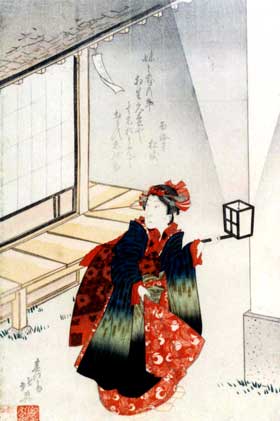| IMOSE NO KADOMATSU |
| Play title | Some Moy˘ Imose no Kadomatsu |
| Author | Suga Sensuke |
| History |
The play "Some Moy˘ Imose no Kadomatsu" was originally written for the puppet theater (Bunraku) and staged for the first time in ďsaka at the Kita-Horie Ichi-no-Gawa Shibai in the 12th lunar month of 1767. It was adapted for Kabuki several years after, in the 4th lunar month of 1782 in ďsaka. This adaptation was produced by Yamashita Kinsaku II at the Naka no Shibai (unknown casting). "Some Moy˘ Imose no Kadomatsu" is no more part of the current Kabuki repertoire but it is still performed in Bunraku; a revival at the National Theatre of this drama in the future to come would not be a big surprise. It is also worthy to note that the role of Zenroku in "Shinpan Ukina no Yomiuri" came directly from "Some Moy˘ Imose no Kadomatsu". |
| Structure |
The original drama was in two parts. |
| Key words |
Bant˘ Decchi Gidayű Ky˘gen Kura Musume Osome-hisamatsumono Sewamono Shichiya |
| Summary |
When Osome, daughter of Tarobŕ, proprietor of the pawnshop in ďsaka, visits the Ikudama Shrine with her lover Hisamatsu, an apprentice at her father's shop, they are embarrassed to hear a ballad book peddler recite a ballad about their "scandalous" love affair. Zenroku, chief clerk at the pawnshop, arrives and tells Osome that he has written the ballad in order to have Hisamatsu expelled from the shop and win Osome as his sweetheart. As Zenroku makes amorous advances to Osome, Hisamatsu stabs him to death with a sword and kills himself with the same weapon. In despair Osome throws herself into a well. What happened in the preceding scene was in fact a dream dreamt by both Osome and Hisamatsu in their midday naps. Hisamatsu says to Osome that he will die alone so that she may be free to marry Seibŕ chosen by her parents as her husband but Osome insists that she will die together with him. She tells him that her mother has discovered in the bathroom that she is already pregnant. When Osome goes away, having been called by her mother Okatsu, Hisamatsu's father Kyűsaku visits the shop to advise him to take a leave of absence from the shop to stay in Kyűsaku's house for a while. As Hisamatsu does not consent, Kyűsaku gets angry and beats him with a leather shoe. Osome, coming back, tells Kyűsaku that she is to blame. Okatsu also enters and asks Osome to marry Seibŕ who is Osome's fiancÚ. Seeing Osome still reluctant, she takes out a razor and tries to kill herself if she does not agree. Osome is thus compelled to give her consent. Kyűsaku takes his leave after confining Hisamatsu to the storehouse to make sure that the lovers will have no more clandestine meetings. Kuramae Late at night Osome stealthily comes to the front of the storehouse. Hisamatsu looks out of the small window and asks her to pray for the repose of his soul after his death. Osome says she will die with him, rejecting her parents' request to marry Seibŕ. Noticing her presence in the dark, her father Tarobŕ opens the sliding door of his room facing the storehouse. He calls her in and tenderly persuades her to marry Seibŕ. When Osome comes out of her father's room, Zenroku, a clerk, approaches her and asks her to elope with him. Saying that he is going to steal valuable articles from the storehouse by using the key he has secretly secured, he unlocks the door of the storehouse when Hisamatsu comes to the doorway and stabs Zenroku with a dagger. Hisamatsu flees with Osome. Zenroku is caught by Seibŕ, who has come to look for Osome. Source: Hironaga Shűzabur˘ |
 |
 |
|
The actors Arashi Rikan II (left print) and Iwai Shijaku I (right print) playing the roles of Osome and Hisamatsu in the "Kuramae" scene of the drama "Some Moy˘ Imose no Kadomatsu", which was staged in the 11th lunar month of 1832 at the Kitagawa no Shibai (print made by Shumbaisai Hokuei) |
|
|
|
| Contact | Main | Top | Updates | Actors | Plays | Playwrights | Programs | Links | FAQ | Glossary | Chronology | Illustrations | Prints | Characters | Derivatives | Theaters | Coming soon | News |